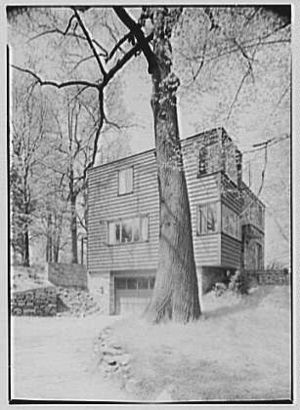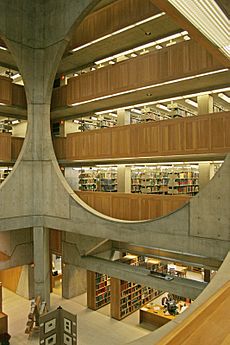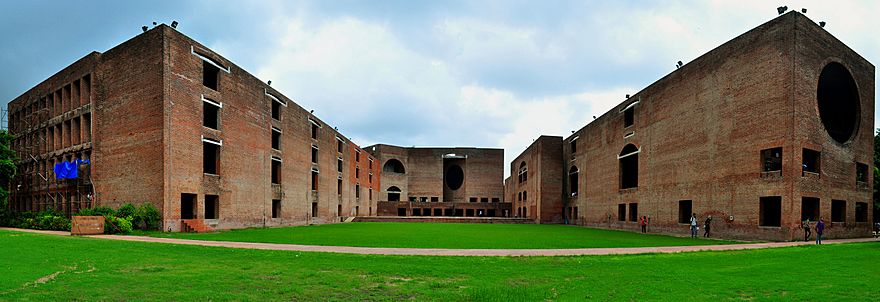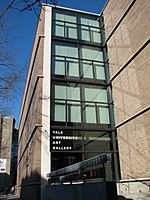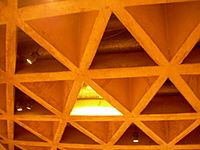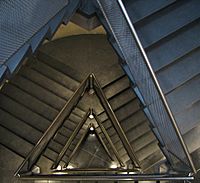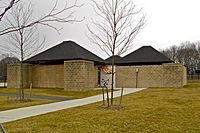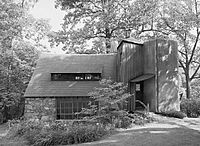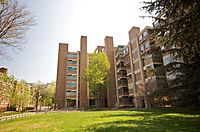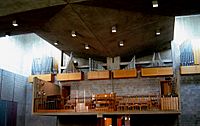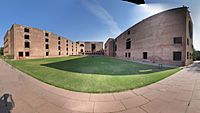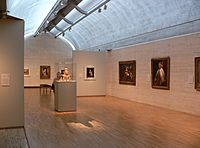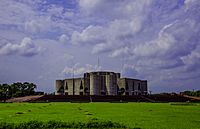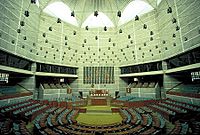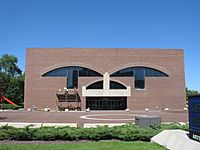Louis Kahn facts for kids
Quick facts for kids
Louis Kahn
|
|
|---|---|
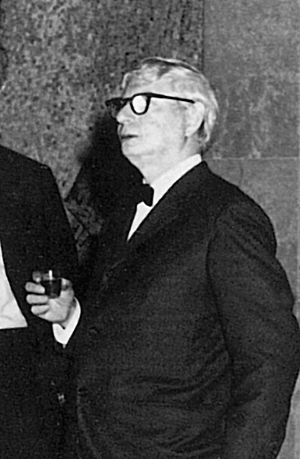 |
|
| Born |
Itze-Leib Schmuilowsky
February 20, 1901 Kuressaare, Governorate of Livonia, Russian Empire (Present-day Kuressaare, Estonia)
|
| Died | March 17, 1974 (aged 73) |
| Nationality | American |
| Occupation | Architect |
| Awards | AIA Gold Medal RIBA Gold Medal |
| Buildings | Jatiyo Sangshad Bhaban Yale University Art Gallery Salk Institute Indian Institute of Management, Ahmedabad Phillips Exeter Academy Library Kimbell Art Museum |
| Projects | Center of Philadelphia, Urban and Traffic Study |
Louis Isadore Kahn (born Itze-Leib Schmuilowsky; February 20, 1901 – March 17, 1974) was a famous American architect. He was born in Estonia and lived in Philadelphia.
Kahn started his own architecture studio in 1935. He also taught architecture at Yale School of Architecture and the University of Pennsylvania. He was known for his strong, heavy buildings that showed off their materials. Many people thought he was "America's foremost living architect" when he passed away.
Contents
Discovering Louis Kahn's Life
His Early Years and Family History
Louis Kahn was born into a poor Jewish family. His original name was Itze-Leib Schmuilowsky. He was born in what is now Estonia, which was part of the Russian Empire back then. Most people believe he was born in Kuressaare.
When he was three, he had an accident with hot coals. He put them in his apron, and it caught fire, burning his face. He had these scars for the rest of his life.
In 1906, his family moved to the United States. They were worried his father might have to join the army. His birth year might have been changed during their immigration. His son's film says his family was too poor to buy pencils. Louis used burnt twigs to draw and earn money. He also played piano for silent movies. He became a U.S. citizen in 1914. His father changed their family name to Kahn in 1915.
Learning to Be an Architect
Louis Kahn was very good at art from a young age. He often won awards for his watercolor paintings in high school. He wasn't very interested in school until he took an architecture class. This class made him want to become an architect.
He turned down a full scholarship to study art. Instead, he worked different jobs to pay for his architecture degree. He studied at the University of Pennsylvania School of Fine Arts. His teacher, Paul Philippe Cret, taught him a style that didn't use too much decoration.
Kahn's Amazing Career Journey
After finishing his architecture degree in 1924, Kahn worked for the city architect, John Molitor. He helped design buildings for a big event called the 1926 Sesquicentennial Exposition.
In 1928, Kahn traveled around Europe. He was very interested in old medieval cities like Carcassonne, France. He also liked the castles in Scotland. He wasn't as interested in the newer, modern buildings.
When he came back to the U.S. in 1929, he worked for his old teacher, Paul Philippe Cret. He also worked with other architecture firms in Philadelphia.
In 1932, Kahn started a group called the Architectural Research Group. They were interested in new ideas for public housing. Kahn worked on designs for public housing projects. These projects were meant to help people during the Great Depression, but they were never built.
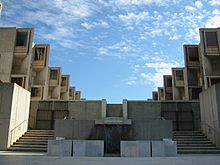
Kahn also worked with other architects like George Howe and Oscar Stonorov. They designed housing developments in Pennsylvania. Kahn and Stonorov even had a formal partnership for several years.
Kahn didn't develop his unique architectural style until he was in his fifties. He visited ancient ruins in Italy, Greece, and Egypt in 1950. This trip changed his way of thinking about design. He started to focus on basic forms and materials. He created his own style, which was influenced by modern ideas but not limited by strict rules.
In the 1950s and 1960s, Kahn helped plan the center of Philadelphia. He designed several plans, but they were never built. He also received a grant to study traffic in Philadelphia.
Kahn started teaching at Yale University in 1947. He later taught at Massachusetts Institute of Technology (MIT). From 1957 until he died, he taught at the University of Pennsylvania. He was also a guest lecturer at Princeton University.
Awards and Special Recognitions
Louis Kahn received many important awards for his work. In 1953, he became a Fellow of the American Institute of Architects (AIA). He was also made a member of the National Institute of Arts and Letters in 1964.
He won the Frank P. Brown Medal in 1964. In 1971, he received the AIA Gold Medal. This is the highest award given by the AIA. The next year, in 1972, he won the Royal Gold Medal from the Royal Institute of British Architects (RIBA). He also received the Golden Plate Award in 1971.
How Louis Kahn Passed Away
In 1974, Louis Kahn had a heart attack. He was at Penn Station in New York City. He had just come back from a work trip to India. Because of some confusion, his wife was not told right away.
A Film About His Life
In 2003, Louis Kahn's son, Nathaniel Kahn, made a documentary film about his father. The film is called My Architect: A Son's Journey. It shows his father's amazing buildings. It also explores Louis Kahn's personal life through his family and friends. The film was even nominated for an Oscar.
Famous Buildings by Kahn
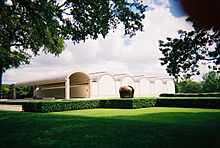
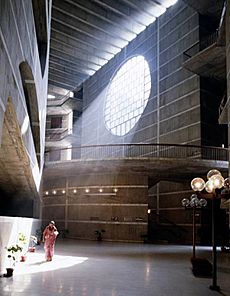
- Yale University Art Gallery, New Haven, Connecticut (1951–1953): This was one of Kahn's first big projects. The ceilings are very thick and have triangular openings. These openings let light in and hide the heating and electrical systems.
- Richards Medical Research Laboratories, University of Pennsylvania, Philadelphia (1957–1965): This building was a big step for Kahn. It showed new ideas for modern architecture. It clearly separated "served" spaces (like labs) from "servant" spaces (like stairs).
- The Salk Institute, La Jolla, California (1959–1965): This campus was planned to have labs, meeting areas, and living spaces. Only the lab buildings were built. They are two parallel blocks with a water garden in the middle. They offer a long view of the Pacific Ocean. Many call it Kahn's most important work.
- First Unitarian Church, Rochester, New York (1959–1969): A famous architecture critic called this one of the greatest religious buildings of the 20th century. Tall, narrow windows create interesting shadows outside. Four light towers fill the inside with soft, natural light.
- Indian Institute of Management, Ahmedabad, India (1961): A large educational campus designed by Kahn.
- Eleanor Donnelly Erdman Hall, Bryn Mawr College, Bryn Mawr, Pennsylvania (1960-1965): This building was designed to look like a modern Scottish castle.
- Phillips Exeter Academy Library, Exeter, New Hampshire (1965–1972): This library won an award in 1997. It has a dramatic main hall with huge circular openings. These openings look into the areas where books are kept.
- Kimbell Art Museum, Fort Worth, Texas (1967–1972): This museum has repeated arched ceilings. Light slits along the top of the arches let in soft, changing light. This light makes the artwork look amazing.
- Arts United Center, Fort Wayne, Indiana (1973): This was the only building built from Kahn's plan for a ten-building arts campus. It is his only theater building.
- Yale Center for British Art, Yale University, New Haven, Connecticut (1969–1974): Another important building at Yale University.
- Franklin D. Roosevelt Four Freedoms Park, Roosevelt Island, New York (1972–1974): This park was completed in 2012, many years after Kahn's death.
- Jatiyo Sangshad Bhaban (National Assembly Building), Dhaka, Bangladesh (1962–1974): This was Kahn's last project. It is the main building of Bangladesh's national capital complex. Many people consider it one of the greatest buildings of the 20th century. It is definitely Kahn's most important work.
Timeline of Louis Kahn's Works
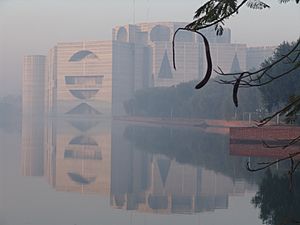
The dates below show when each project began.
- 1935 – Jersey Homesteads Cooperative Development, Hightstown, New Jersey
- 1940 – Jesse Oser House, Elkins Park, Pennsylvania
- 1944 – Carver Court, Coatsville, Pennsylvania
- 1947 – Phillip Q. Roche House, Conshohocken, Pennsylvania
- 1950 - Morton and Lenore Weiss House, East Norriton, Pennsylvania
- 1951 – Yale University Art Gallery, New Haven, Connecticut
- 1952 – City Tower Project, Philadelphia, Pennsylvania (not built)
- 1954 – Jewish Community Center (including Trenton Bath House), Ewing, New Jersey
- 1956 – Wharton Esherick Studio, Malvern, Pennsylvania (designed with Wharton Esherick)
- 1957 – Richards Medical Research Laboratories, University of Pennsylvania, Philadelphia, Pennsylvania
- 1957 – Fred E. and Elaine Cox Clever House, Cherry Hill, New Jersey
- 1959 – Margaret Esherick House, Chestnut Hill, Philadelphia, Pennsylvania
- 1958 – Tribune Review Publishing Company Building, Greensburg, Pennsylvania
- 1959 – Salk Institute for Biological Studies, La Jolla, California
- 1959 – First Unitarian Church, Rochester, New York
- 1960 – Erdman Hall Dormitories, Bryn Mawr College, Bryn Mawr, Pennsylvania
- 1960 – Norman Fisher House, Hatboro, Pennsylvania
- 1961 – Point Counterpoint, a converted boat for performances
- 1961 - Philadelphia's Mikveh Israel, Philadelphia, Pennsylvania (not built)
- 1961 – Indian Institute of Management, Ahmedabad, India
- 1962 – Jatiyo Sangshad Bhaban, the National Assembly Building of Bangladesh, Dhaka, Bangladesh
- 1963 – President's Estate, Islamabad, Pakistan (not built)
- 1965 – Phillips Exeter Academy Library, Exeter, New Hampshire
- 1966 – Kimbell Art Museum, Fort Worth, Texas
- 1966 – Olivetti-Underwood Factory, Harrisburg, Pennsylvania
- 1966 - Temple Beth El of Northern Westchester, Chappaqua, New York
- 1968 – Hurva Synagogue, Jerusalem, Israel (not built)
- 1969 – Yale Center for British Art, Yale University, New Haven, Connecticut
- 1971 – Steven Korman House, Fort Washington, Pennsylvania
- 1973 – Arts United Center, Fort Wayne, Indiana
- 1974 – Franklin D. Roosevelt Four Freedoms Park, Roosevelt Island, New York City, completed 2012.
- 1976 – Point Counterpoint II, an improved concert boat, debuted after his death.
- 1979 – Flora Lamson Hewlett Library of the Graduate Theological Union, Berkeley, California
Louis Kahn's Lasting Influence
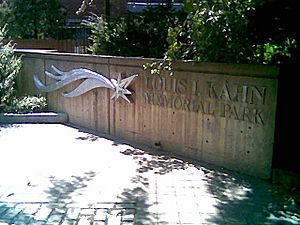
Louis Kahn's buildings were unique. He used the modern "International Style" but added his own special touch. The artist Isamu Noguchi called him "a philosopher among architects."
Kahn liked to clearly separate different types of spaces. He called them "served" spaces and "servant" spaces. "Servant" spaces were not for actual servants. They were areas that supported other main spaces. Examples include stairwells, hallways, bathrooms, or storage rooms.
He often used rough materials like brick and bare concrete. He would place them next to smooth surfaces like marble. This made the textures stand out.
Kahn worked closely with engineers and builders on his projects. His ideas influenced many architects who came after him. Some of his unbuilt projects, like the City Tower, also inspired architects who designed "high-tech" buildings later on. Many famous architects studied under Louis Kahn.
Years after his death, Louis Kahn's work continues to be discussed and admired.
A park called Franklin D. Roosevelt Four Freedoms Park was built in his honor. It opened to the public in 2012.
Gallery
-
Trenton Bath House and Day Camp (1954)
-
Wharton Esherick Studio, 1520 Horseshoe Trail, Malvern, Pennsylvania (1956). Designed with Wharton Esherick
-
Richards Medical Research Laboratories, University of Pennsylvania, 3700 Hamilton Walk, Philadelphia, Pennsylvania (1957–1965)
-
Interior of Kimbell Art Museum, Fort Worth, Texas (1966)
-
Yale Center for British Art, Yale University, New Haven, Connecticut (1969–1974)
-
Parliament of Bangladesh (2014)
See also
 In Spanish: Louis Isadore Kahn para niños
In Spanish: Louis Isadore Kahn para niños


